Voyager 1 Trajectory through the Solar System
- Released Thursday, August 31, 2017
- Visualizations by:
- Tom Bridgman
This visualization tracks the trajectory of the Voyager 1 spacecraft through the solar system. Launched on September 5, 1977, it was one of two spacecraft sent to visit the giant planets of the outer solar system. Voyager 1 flew by Jupiter and Saturn before being directed out of the solar system. To fit the 40 year history of the mission into a short visualization, the pacing of time accelerates through most of the movie, starting at about 5 days per second at the beginning and speeding up to about 11 months per second after the planet flybys are past. The termination shock and heliopause are the 'boundaries' created when the plasma between the stars interacts with the plasma flowing outward from the Sun. They are represented with simple grid models and oriented so their 'nose' is pointed in the direction (Right Ascension = 17h 24m, declination = 17 degrees south) represented by more recent measurements from other missions.
Visualization centered on the Voyager 1 trajectory through the solar system.
- Voyager.ChaseV1.HD1080i_p30.mp4 (1920x1080) [120.3 MB]
- Voyager.ChaseV1.HD1080i_p30.webm (1920x1080) [15.4 MB]
- Voyager.ChaseV1.clockSlate_2160p30.mp4 (3840x2160) [210.8 MB]
- frames/1920x1080_16x9_30p/Voyager.ChaseV1.clockSlate/ (1920x1080) [256.0 KB]
- frames/3840x2160_16x9_30p/Voyager.ChaseV1.clockSlate/ (3840x2160) [256.0 KB]
- Voyager.ChaseV1.clockSlate_Track.HD1080i.03905_print.jpg (1024x576) [96.8 KB]
- Voyager.ChaseV1.clockSlate_Track.HD1080i.03905_searchweb.png (320x180) [68.6 KB]
- Voyager.ChaseV1.clockSlate_Track.HD1080i.03905_thm.png (80x40) [4.4 KB]
Voyager 1's 'Family Portrait' On Valentine's Day 1990, Voyager 1's camera were pointed back at the solar system to image the planets. Check out Voyager at NASA/JPL for more information.
- Voyager.ChaseV1.clockSlate_Track.UHD3840.00000_print.jpg (1024x576) [104.9 KB]
Opening view of Earth orbit looking outward to the rest of the solar system.
- Voyager.ChaseV1.clockSlate_Track.UHD3840.00550_print.jpg (1024x576) [117.4 KB]
Voyager 1 (and 2) cross the orbit of Mars, slightly above the ecliptic plane to avoid the asteroid belt between Mars & Jupiter.
- Voyager.ChaseV1.clockSlate_Track.UHD3840.01490_print.jpg (1024x576) [113.3 KB]
The camera moves out ahead of the Voyagers for a view back at the inner solar system.
- Voyager.ChaseV1.clockSlate_Track.UHD3840.01990_print.jpg (1024x576) [102.3 KB]
Voyager 1 just after the Jupiter flyby on March 5, 1979.
- Voyager.ChaseV1.clockSlate_Track.UHD3840.02420_print.jpg (1024x576) [101.8 KB]
Voyager 1 just before the Saturn flyby on November 12, 1980.
- Voyager.ChaseV1.clockSlate_Track.UHD3840.02990_print.jpg (1024x576) [123.1 KB]
With a gravity-assist from the Saturn flyby, Voyager 1 is directed above the plane of the solar system and continues outward. This is near the time of the Voyager 1 'Family Portrait'. The orbit of Pluto is the grey orbit visible above the orbits of the other planets.
- Voyager.ChaseV1.clockSlate_Track.UHD3840.03350_print.jpg (1024x576) [97.5 KB]
Voyager 1 crosses the termination shock of the solar wind. For simplified and symmetric termination shock model, the timing is not accurate. In reality, this crossing occurred around December of 2004.
- Voyager.ChaseV1.clockSlate_Track.UHD3840.03900_print.jpg (1024x576) [99.4 KB]
Voyager 1 (and 2) beyond the heliopause near the end of 2017.
A slightly sped-up version of the Voyager 1 visualization above, reducing the time for the Voyagers to cross the asteroid belt.
- Voyager1SpedUp.m4v (1920x1080) [123.0 MB]
- Voyager1SpedUp.webm (1920x1080) [12.2 MB]
- Voyager1_Sped_Up-HD1080p.mov (1920x1080) [185.8 MB]
- Voyager1_Sped_Up.mov (1920x1080) [1.7 GB]
- Voyager_1_Sped_Up_4k-H264.mov (3840x2160) [639.6 MB]
- Voyager_1_Sped_Up_4k_ProRes.mov (3840x2160) [7.2 GB]
- Voyager1SpedUp.00500_print.jpg (1024x576) [122.6 KB]
- Solar System
Please give credit for this item to: NASA's Scientific Visualization Studio
- Tom Bridgman (Global Science and Technology, Inc.)
- Kathalina Tran (KBR Wyle Services, LLC)
- Genna Duberstein (USRA)
- Scott Wiessinger (USRA)

Project support
- Laurence Schuler (ADNET Systems, Inc.)
- Ian Jones (ADNET Systems, Inc.)
Release date
This page was originally published on Thursday, August 31, 2017. This page was last updated on Wednesday, November 15, 2023 at 12:05 AM EST.
- Voyager @ 40
- Voyager Retrospective
Datasets used in this visualization
Planetary ephemerides SPICE kernel
Note: While we identify the data sets used in these visualizations, we do not store any further details, nor the data sets themselves on our site.
Hubble’s Brand New Image of Jupiter
Where is the edge of the solar system, voyager 2 trajectory through the solar system, revisiting the pale blue dot at 30, you may also like..., no results., an error occurred. please reload this page and try again..

Voyager 1 Ephemeris Calculator
Compute the position of Voyager 1 for any date and time between 1 January 2013 and 30 December 2099 and display the results on an interactive star map.
In Evidence
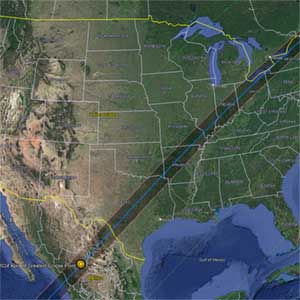
Voyager 1 is a space probe launched by NASA on September 5, 1977, to study the outer Solar System and beyond. It is currently the most distant human-made object from Earth, having traveled over 14 billion miles (23 billion kilometers) from the Sun. Voyager 1's mission has included flybys of Jupiter and Saturn, with the goal of studying their moons, rings, and magnetic fields. The probe is now traveling through the heliosheath , the outermost layer of the Sun's heliosphere, and is expected to enter interstellar space in the coming years. Voyager 1 carries a golden record that contains sounds and images selected to portray the diversity of life and culture on Earth, in the event that it is ever encountered by extraterrestrial life.
Voyager 1 is currently in the constellation of Ophiucus , at a distance of 24,329,974,154 kilometers from Earth.

Today's rise, transit and set times of Voyager 1 from Greenwich, United Kingdom edit_location_alt (all times relative to the local timezone Europe/London):
- Voyager 1 is below the horizon from Greenwich, United Kingdom edit_location_alt .
- Go to interactive sky chart
If you need to access this information frequently for your observations, you can create a simple customized Quick Access page , so that you can easily bookmark it in your browser favorites or add a shortcut to your mobile phones' home screen.
- Position and finder charts (see also Where is Voyager 1? )
- Distance from Earth (see also How far is Voyager 1 from Earth? )
- When does Voyager 1 rise and set?
- Interactive orbit visualization . 3d visualization showing the orbit of Voyager 1 with respect to the major Solar System objects.
- 15 days ephemerides . Table showing celestial coordinates and magnitude of Voyager 1 for the past and next 7 days.
- Interactive sky chart . An online planetarium application that shows where to locate Voyager 1 in the sky from your location.
- Live position tracker . A high precision sky chart that uses real deep sky imagery to help locate Voyager 1 with your telescope or on your astrophotographies.
Voyager 1 Position and Finder Charts
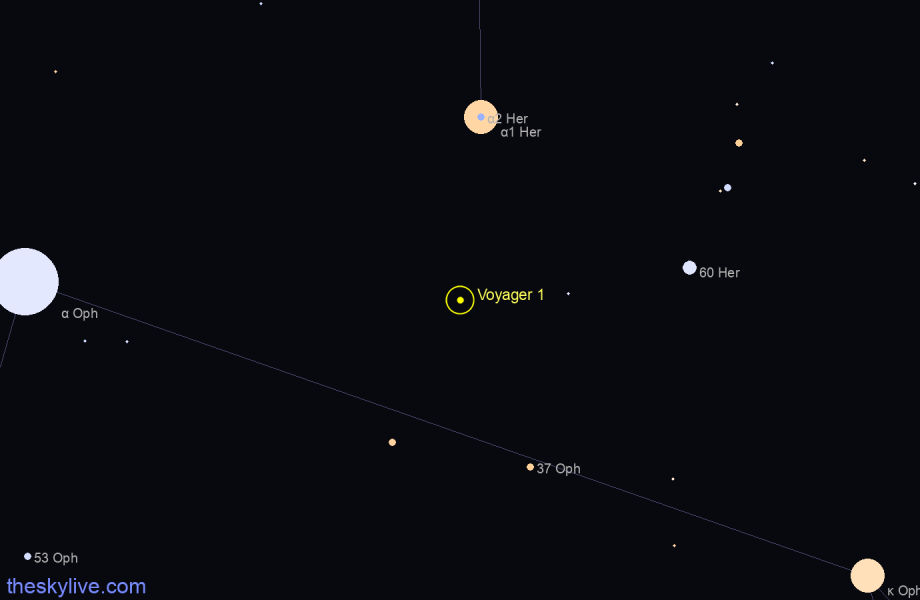
Higher precision deep sky finder chart, 60 arcmin wide, showing where Voyager 1 is right now. Click on the image to see a more detailed fullscreen tracker view .

Also check out Where is Voyager 1? , a page that provides all the information needed to find Voyager 1 in the sky and additional links to sky charts.
Voyager 1 Distance from Earth
The distance of Voyager 1 from Earth is currently 24,329,974,154 kilometers, equivalent to 162.635832 Astronomical Units . Light takes 22 hours, 32 minutes and 36.0581 seconds to travel from Voyager 1 and arrive to us.
The following chart shows the distance of Voyager 1 from Earth as a function of time. In the chart the distance data is measured in Astronomical Units and sampled with an interval of 1 day.
Closest Approach of Voyager 1 to Earth
NOTE: values for the closest approach are computed with a sampling interval of 1 day.
Visualization of Voyager 1 Orbit
This 3d orbit diagram is a feature of our 3D Solar System Simulator and shows the orbit of Voyager 1 with respect of the Sun and the orbits of the major planets . The position of Voyager 1 and the planets along their orbits in this diagram accurately represents the current configuration of the objects in the Solar System. This is an experimental feature and it requires a WebGL enabled browser. Please provide us feedback !
Voyager 1 15 Days Ephemeris
The following table lists the ephemerides of Voyager 1 computed for the past and next 7 days, with a 24 hours interval. Click on each row of the table to locate Voyager 1 in our Online Planetarium at the chosen date.
- Share full article
Advertisement
Supported by

Voyager 1, First Craft in Interstellar Space, May Have Gone Dark
The 46-year-old probe, which flew by Jupiter and Saturn in its youth and inspired earthlings with images of the planet as a “Pale Blue Dot,” hasn’t sent usable data from interstellar space in months.

By Orlando Mayorquin
When Voyager 1 launched in 1977, scientists hoped it could do what it was built to do and take up-close images of Jupiter and Saturn. It did that — and much more.
Voyager 1 discovered active volcanoes, moons and planetary rings, proving along the way that Earth and all of humanity could be squished into a single pixel in a photograph, a “ pale blue dot, ” as the astronomer Carl Sagan called it. It stretched a four-year mission into the present day, embarking on the deepest journey ever into space.
Now, it may have bid its final farewell to that faraway dot.
Voyager 1 , the farthest man-made object in space, hasn’t sent coherent data to Earth since November. NASA has been trying to diagnose what the Voyager mission’s project manager, Suzanne Dodd, called the “most serious issue” the robotic probe has faced since she took the job in 2010.
The spacecraft encountered a glitch in one of its computers that has eliminated its ability to send engineering and science data back to Earth.
The loss of Voyager 1 would cap decades of scientific breakthroughs and signal the beginning of the end for a mission that has given shape to humanity’s most distant ambition and inspired generations to look to the skies.
“Scientifically, it’s a big loss,” Ms. Dodd said. “I think — emotionally — it’s maybe even a bigger loss.”
Voyager 1 is one half of the Voyager mission. It has a twin spacecraft, Voyager 2.
Launched in 1977, they were primarily built for a four-year trip to Jupiter and Saturn , expanding on earlier flybys by the Pioneer 10 and 11 probes.
The Voyager mission capitalized on a rare alignment of the outer planets — once every 175 years — allowing the probes to visit all four.
Using the gravity of each planet, the Voyager spacecraft could swing onto the next, according to NASA .
The mission to Jupiter and Saturn was a success.
The 1980s flybys yielded several new discoveries, including new insights about the so-called great red spot on Jupiter, the rings around Saturn and the many moons of each planet.
Voyager 2 also explored Uranus and Neptune , becoming in 1989 the only spacecraft to explore all four outer planets.

Voyager 1, meanwhile, had set a course for deep space, using its camera to photograph the planets it was leaving behind along the way. Voyager 2 would later begin its own trek into deep space.
“Anybody who is interested in space is interested in the things Voyager discovered about the outer planets and their moons,” said Kate Howells, the public education specialist at the Planetary Society, an organization co-founded by Dr. Sagan to promote space exploration.
“But I think the pale blue dot was one of those things that was sort of more poetic and touching,” she added.
On Valentine’s Day 1990, Voyager 1, darting 3.7 billion miles away from the sun toward the outer reaches of the solar system, turned around and snapped a photo of Earth that Dr. Sagan and others understood to be a humbling self-portrait of humanity.
“It’s known the world over, and it does connect humanity to the stars,” Ms. Dodd said of the mission.
She added: “I’ve had many, many many people come up to me and say: ‘Wow, I love Voyager. It’s what got me excited about space. It’s what got me thinking about our place here on Earth and what that means.’”
Ms. Howells, 35, counts herself among those people.
About 10 years ago, to celebrate the beginning of her space career, Ms. Howells spent her first paycheck from the Planetary Society to get a Voyager tattoo.
Though spacecraft “all kind of look the same,” she said, more people recognize the tattoo than she anticipated.
“I think that speaks to how famous Voyager is,” she said.
The Voyagers made their mark on popular culture , inspiring a highly intelligent “Voyager 6” in “Star Trek: The Motion Picture” and references on “The X Files” and “The West Wing.”
Even as more advanced probes were launched from Earth, Voyager 1 continued to reliably enrich our understanding of space.
In 2012, it became the first man-made object to exit the heliosphere, the space around the solar system directly influenced by the sun. There is a technical debate among scientists around whether Voyager 1 has actually left the solar system, but, nonetheless, it became interstellar — traversing the space between stars.
That charted a new path for heliophysics, which looks at how the sun influences the space around it. In 2018, Voyager 2 followed its twin between the stars.
Before Voyager 1, scientific data on the sun’s gases and material came only from within the heliosphere’s confines, according to Dr. Jamie Rankin, Voyager’s deputy project scientist.
“And so now we can for the first time kind of connect the inside-out view from the outside-in,” Dr. Rankin said, “That’s a big part of it,” she added. “But the other half is simply that a lot of this material can’t be measured any other way than sending a spacecraft out there.”
Voyager 1 and 2 are the only such spacecraft. Before it went offline, Voyager 1 had been studying an anomalous disturbance in the magnetic field and plasma particles in interstellar space.
“Nothing else is getting launched to go out there,” Ms. Dodd said. “So that’s why we’re spending the time and being careful about trying to recover this spacecraft — because the science is so valuable.”
But recovery means getting under the hood of an aging spacecraft more than 15 billion miles away, equipped with the technology of yesteryear. It takes 45 hours to exchange information with the craft.
It has been repeated over the years that a smartphone has hundreds of thousands of times Voyager 1’s memory — and that the radio transmitter emits as many watts as a refrigerator lightbulb.
“There was one analogy given that is it’s like trying to figure out where your cursor is on your laptop screen when your laptop screen doesn’t work,” Ms. Dodd said.
Her team is still holding out hope, she said, especially as the tantalizing 50th launch anniversary in 2027 approaches. Voyager 1 has survived glitches before, though none as serious.
Voyager 2 is still operational, but aging. It has faced its own technical difficulties too.
NASA had already estimated that the nuclear-powered generators of both spacecrafts would likely die around 2025.
Even if the Voyager interstellar mission is near its end, the voyage still has far to go.
Voyager 1 and its twin, each 40,000 years away from the next closest star, will arguably remain on an indefinite mission.
“If Voyager should sometime in its distant future encounter beings from some other civilization in space, it bears a message,” Dr. Sagan said in a 1980 interview .
Each spacecraft carries a gold-plated phonograph record loaded with an array of sound recordings and images representing humanity’s richness, its diverse cultures and life on Earth.
“A gift across the cosmic ocean from one island of civilization to another,” Dr. Sagan said.
Orlando Mayorquin is a general assignment and breaking news reporter based in New York. More about Orlando Mayorquin
What’s Up in Space and Astronomy
Keep track of things going on in our solar system and all around the universe..
Never miss an eclipse, a meteor shower, a rocket launch or any other 2024 event that’s out of this world with our space and astronomy calendar .
Scientists may have discovered a major flaw in their understanding of dark energy, a mysterious cosmic force . That could be good news for the fate of the universe.
A new set of computer simulations, which take into account the effects of stars moving past our solar system, has effectively made it harder to predict Earth’s future and reconstruct its past.
Dante Lauretta, the planetary scientist who led the OSIRIS-REx mission to retrieve a handful of space dust , discusses his next final frontier.
A nova named T Coronae Borealis lit up the night about 80 years ago. Astronomers say it’s expected to put on another show in the coming months.
Is Pluto a planet? And what is a planet, anyway? Test your knowledge here .
- Skip to Nav
- Skip to Main
- Skip to Footer
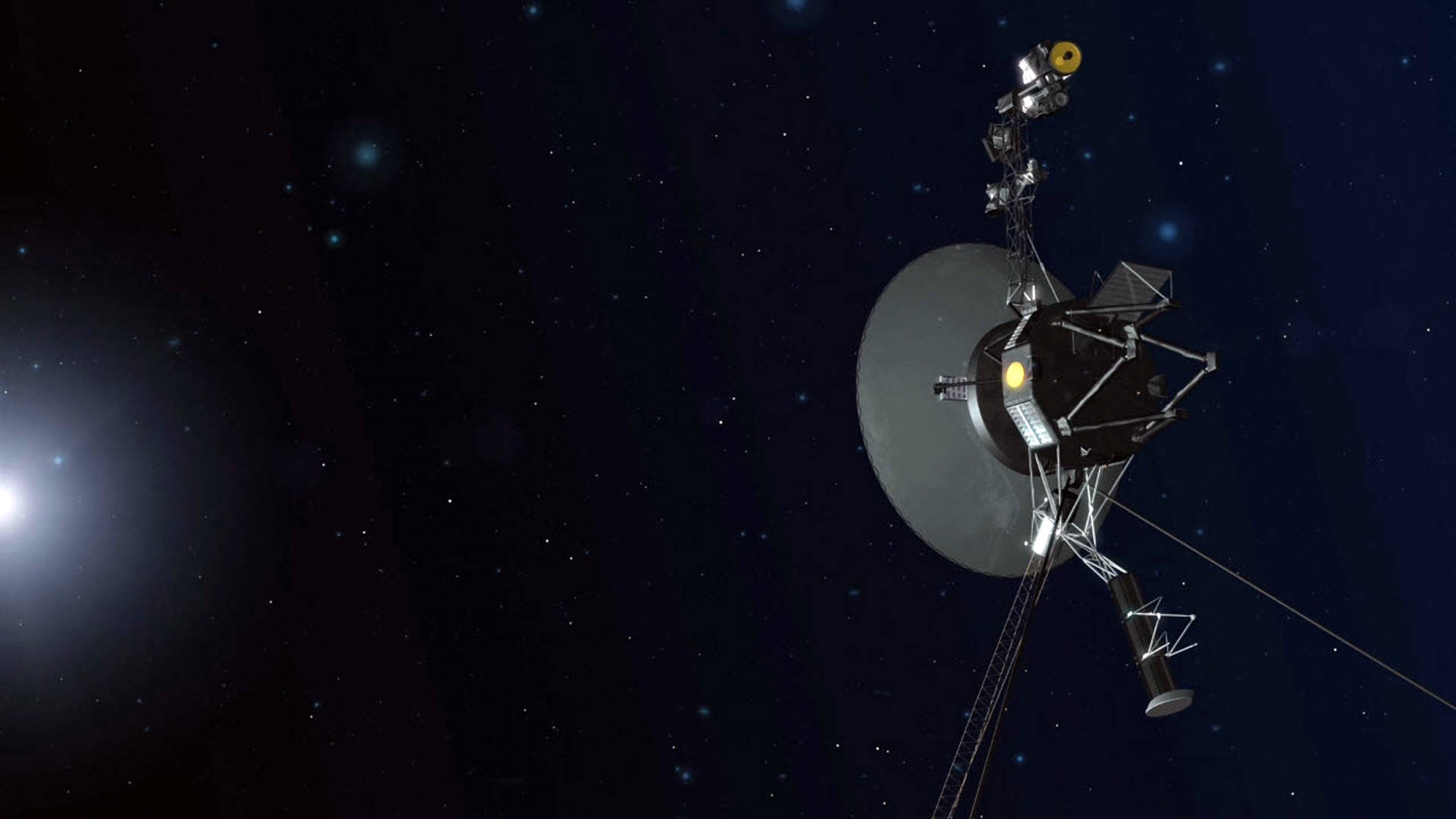
Voyager Is 13 Billion Miles Away and Needs a Repair: Here's What Happened
Please try again
Trickling in through the giant radio dishes of NASA’s Deep Space Network, faint whispers from a distant robotic explorer deliver a message: I may not have much time left .
It is Voyager 1, our most distant explorer, still functioning and communicating with NASA as it speeds ever farther into deep space.
The message is not a literal S.O.S. signal, but data from Voyager’s engine system alerting NASA engineers that a problem is on the horizon: Voyager may soon lose the ability to align its radio dish — its communication lifeline — with Earth.
Loss of contact with Voyager would spell the end of a more than 40-year career of discovery, an odyssey that began with the exploration of Jupiter and Saturn and continued in a long-distance quest to find the very edge of interstellar space.
Decades ago the “ grand tour ” of Voyagers 1 and 2 brought us remarkable images and discoveries from Jupiter, Saturn, Uranus, Neptune and their moons.
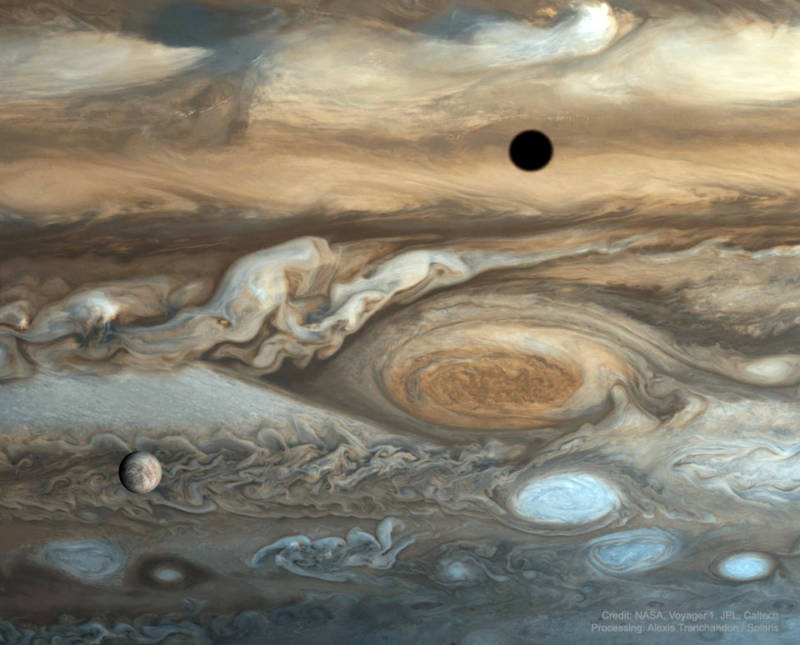
They revealed active volcanoes on Io, hinted at a huge liquid-water ocean under Europa’s ice crust, and piqued our curiosity for Saturn’s mysterious, cloud-shrouded Titan. They showed us stunning pictures of Jupiter’s cloud belts and huge storm systems, and opened our eyes to exquisite details of Saturn’s rings.
After traveling more than 13 billion miles, Voyager 1 has only recently crossed that threshold beyond the reach of our sun and entered interstellar space. With a vast, unexplored realm laid out ahead, an untimely end to Voyager’s mission now would be a tremendous loss. Scientists are hungry to learn more about what lies between the stars of our galaxy.
Voyager 1’s Check Engine Light Came On
It was inevitable that at some point, Voyager 1’s ability to keep in touch would start to fade. Operating such a remote space observatory presents several technical challenges, not the least of which is maintaining radio communications over great distance. NASA does this by keeping Voyager’s main radio dish aligned with Earth and the giant radio dishes of NASA’s Deep Space Network .
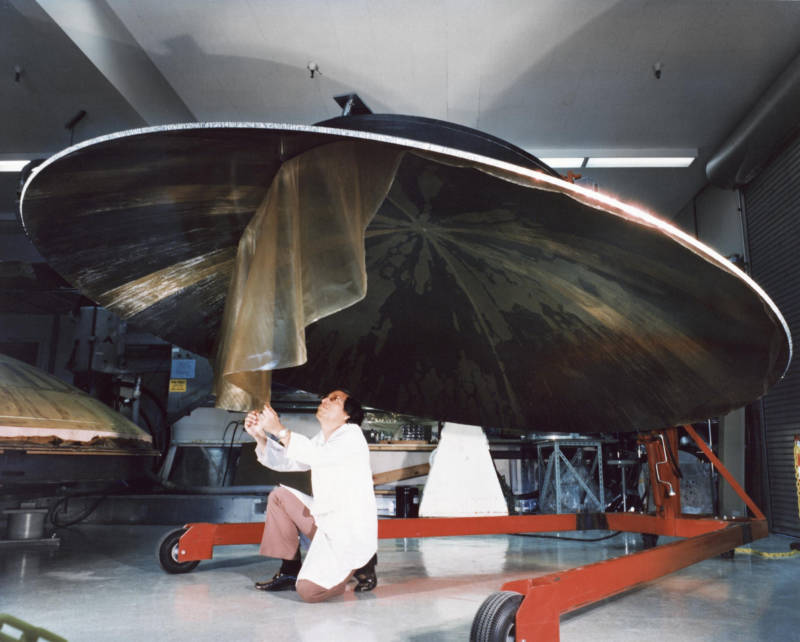
Left to its own inertia, the spacecraft would slowly rotate out of alignment, reacting to the subtle but persistent forces of things like pressure from sunlight and the solar wind.
To date, Voyager 1 has used a set of “attitude control thrusters” that fire in tiny bursts to subtly steer the spacecraft to maintain alignment. But over the last few years, NASA has noticed that these thrusters are degrading, producing less and less thrust and requiring longer bursts to do their job.
How To Take A Spaceship to the Mechanic
You don’t keep driving your car when the engine begins to sputter, if you plan to keep driving it. You take it to a mechanic.
Since bringing Voyager in for a tune-up isn’t an option, NASA engineers had to imagine how to sustain Voyager’s mission health using on-board resources. Remember that scene from Apollo 13 when the engineers had to figure out a way for the astronauts to fix the carbon dioxide removal system using plastic bags and duct tape?
The workaround for Voyager 1 was to attempt to reenlist a different set of engines that had been shut down for 37 years.
These are Voyager’s “trajectory correction maneuver (TCM) thrusters.” They hadn’t been tested since NASA engineers last used them to help Voyager 1 maneuver through the Saturn system to make close flybys of the planet and its large moon, Titan. Once the Saturn flyby was over, the TCM thrusters were no longer needed, and were shut down.
On November 28, 2017, NASA sent the command to Voyager to test-fire the TCM thrusters. That radio signal travelled through space for 19.5 hours to reach Voyager (that’s now far away it is), while NASA engineers waited.
Then, after another 19.5 hours of silence, NASA’s Goldstone radio antenna in the Mojave Desert received word from Voyager 1 that the thrusters had fired!
NASA now has a path forward to keep Voyager 1’s communication dish facing Earth for at least another two or three years, by switching to the TCM system once the current thrusters have gone off-line.
The Voyager Legacy
Launched in 1977, Voyager 1’s primary mission was to make flybys of the Jupiter and Saturn systems before being flung by Saturn’s gravity onto a course that would take it out of the solar system, bound for interstellar space.
Now, Voyager 1 is the most distant human-made object from Earth, and has been since it overtook the venerable Pioneer 10 in 1998. As of March 2018, Voyager 1 is over 13 billion miles away—or 141 times farther from the sun than Earth is.
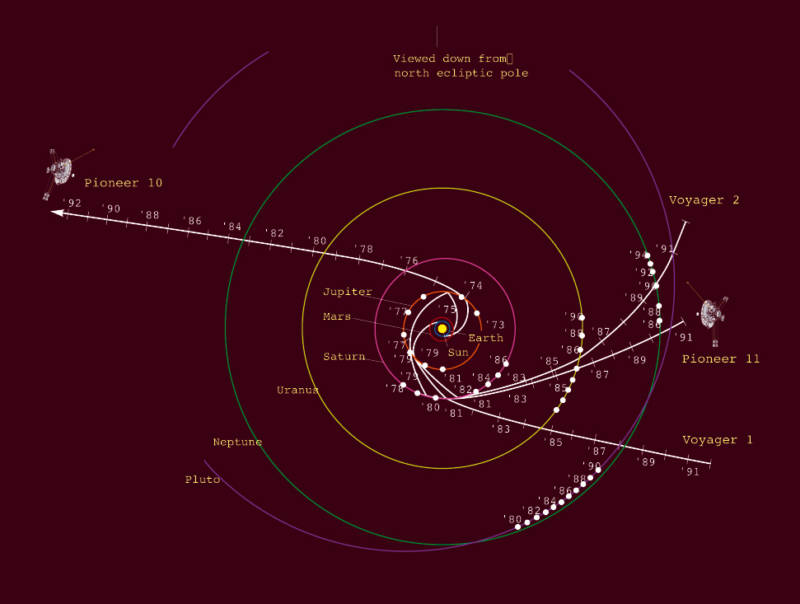
Voyager 2, now over 10 billion miles out, followed a different path from its twin, cruising on to Uranus and then Neptune after visiting Jupiter and Saturn. Voyager 2 became the only spacecraft to visit all four gas giant planets, and the only one ever to visit Uranus or Neptune.
Interstellar Envoys
After departing the realm of the gas giants, both Voyagers became de facto envoys to interstellar space, having achieved solar escape velocity during their planetary flybys.
From that point on, the Voyagers’ mission switched from being planetary explorers to becoming remote outposts measuring properties of the space around them—the speed and direction of the solar wind and associated magnetic fields, the activity of electrically charged particles flying by.
Think of the Voyagers as extremely remote weather stations, reporting back the “space weather” conditions as they coast to ever greater distances.
For many years, Voyager mission scientists studied the trickle of data beamed back from both spacecraft, waiting for the day when one or both might report a change in the particle or magnetic environment—a “shift in the wind” indicating a probe had entered interstellar space.
In August 2012, Voyager 1 officially crossed over , detecting a large increase in charged particles coming from interstellar space—particles that are normally deflected by the solar wind.
The difference between interstellar space and the bubble of solar wind surrounding the sun is subtle, and you wouldn’t notice a change with any human senses. In fact, in either case, human senses would report only empty space.
But with its sensitive particle and magnetic field detectors, Voyager 1 is giving us our first taste of what lies between the stars. The longer it stays in communication with us, the deeper into the galaxy we will probe.
To learn more about how we use your information, please read our privacy policy.

The remarkable twin Voyager spacecraft continue to explore the outer reaches of the solar system decades after they completed their surveys of the Outer Planets. Launched in 1977 (September 5 for Voyager 1 (V1) and August 20 for Voyager 2 (V2), whose trajectory took it past Jupiter after Voyager 1), the spacecraft pair made many fundamental discoveries as they flew past Jupiter (March 1979 for V1, July 1979 for V2) and Saturn (November 1980 for V1, August 1981 for V2). The path of Voyager 2 past Saturn was targeted so that it continued within the plane of the solar system, allowing it to become the first spacecraft to visit Uranus (January 1986) and Neptune (August 1989). Following the Neptune encounter, both spacecraft started a new phase of exploration under the intriguing title of the Voyager Interstellar Mission.
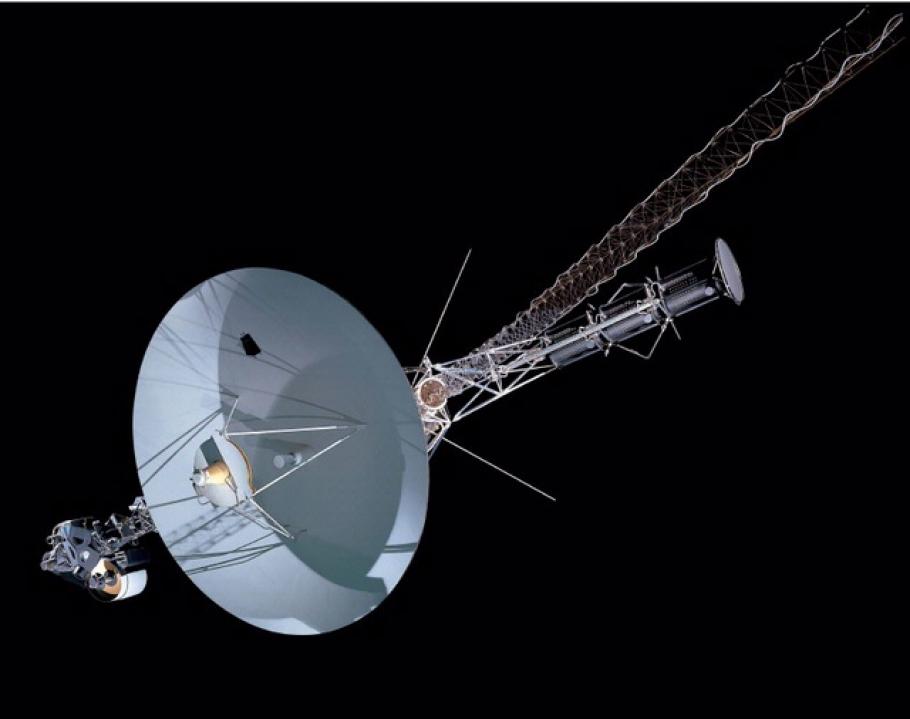
Five instruments continue to collect important measurements of magnetic fields, plasmas, and charged particles as both spacecraft explore different portions of the solar system beyond the orbits of the planets. Voyager 1 is now more than 118 astronomical units (one AU is equal to the average orbital distance of Earth from the Sun) distant from the sun, traveling at a speed (relative to the sun) of 17.1 kilometers per second (10.6 miles per second). Voyager 2 is now more than 96 AU from the sun, traveling at a speed of 15.5 kilometers per second (9.6 miles per second). Both spacecraft are moving considerably faster than Pioneers 10 and 11, two earlier spacecraft that became the first robotic visitors to fly past Jupiter and Saturn in the mid-70s.
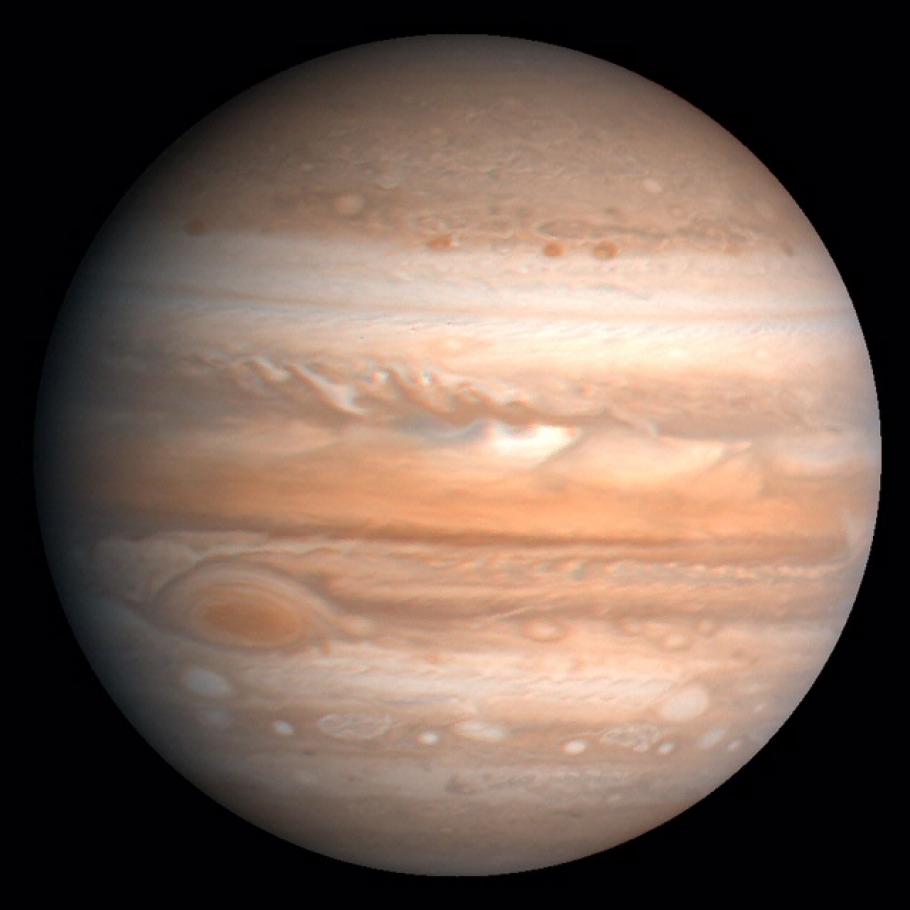
This processed color image of Jupiter was produced in 1990 by the U.S. Geological Survey from a Voyager image captured in 1979. The colors have been enhanced to bring out detail. Zones of light-colored, ascending clouds alternate with bands of dark, descending clouds. The clouds travel around the planet in alternating eastward and westward belts at speeds of up to 540 kilometers per hour. Tremendous storms as big as Earthly continents surge around the planet. The Great Red Spot (oval shape toward the lower-left) is an enormous anticyclonic storm that drifts along its belt, eventually circling the entire planet.
As seen in the night sky at Earth, Voyager 1 is within the confines of the constellation Ophiuchus, only slightly above the celestial equator; no telescope can see it, but radio contact is expected to be maintained for at least the next ten years. Voyager 2 is within the bounds of the constellation Telescopium (which somehow sounds quite appropriate) in the far southern night sky.
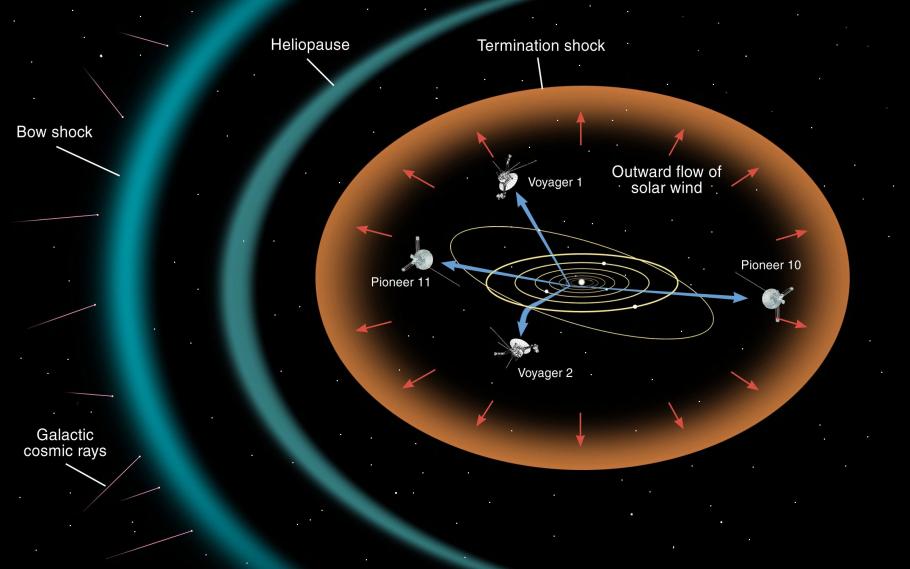
Both spacecraft have already passed something called the Termination Shock † (December 2004 for V1, August 2007 for V2), where the solar wind slows as it starts to interact with the particles and fields present between the stars. It is expected that both spacecraft will encounter the Heliopause, where the solar wind ceases as true interstellar space begins, from 10 to 20 years after crossing the Termination Shock. Theories exist for what should be present in interstellar space, but the Voyagers will become the first man-made objects to go beyond the influences of the Sun, hopefully returning the first measurements of what it is like out there. Each spacecraft is carrying a metal record with encoded sounds and sights from Earth, along with the needle needed to read the recordings, and simplified instructions for where the spacecraft came from, in case they are eventually discovered by intelligent extra-terrestrials.
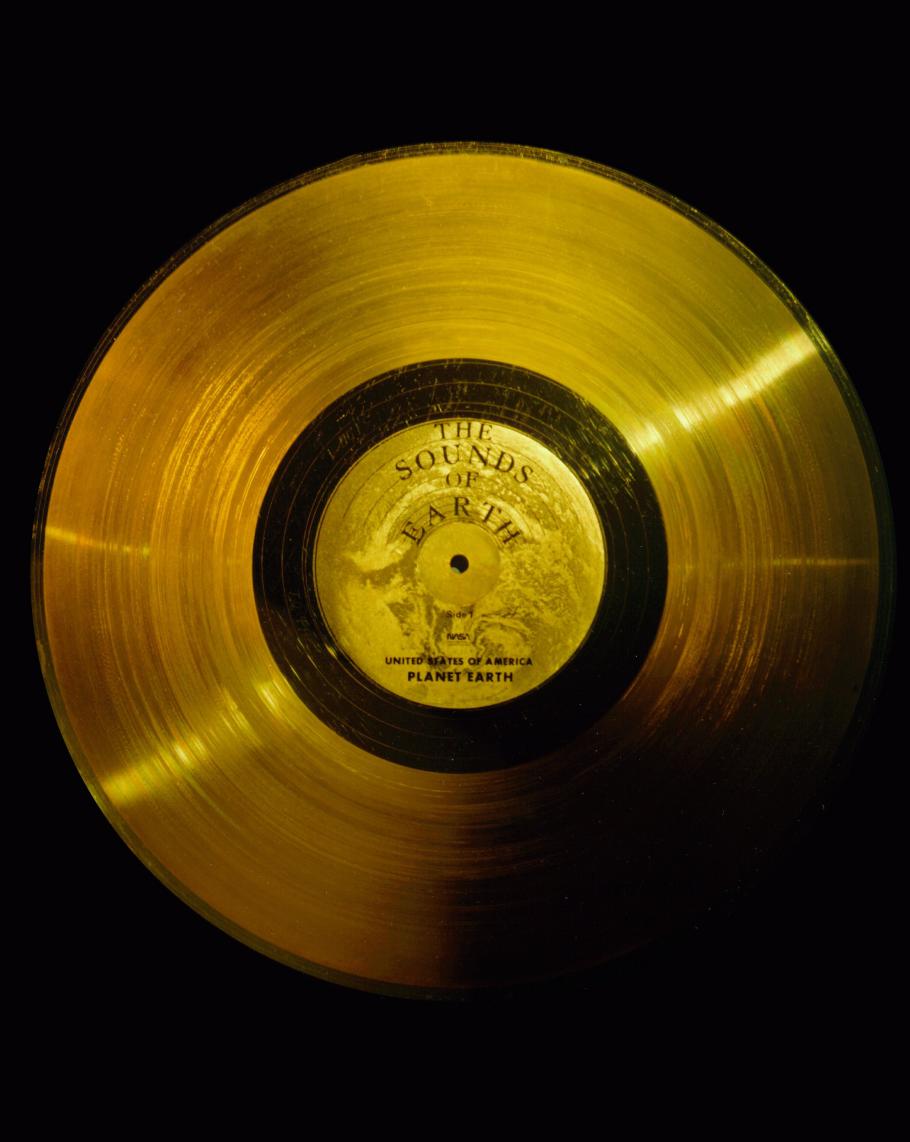
Keep track of the Voyager spacecraft on the official Voyager Interstellar Mission website or follow @NASAVoyager2 on Twitter. † The sun ejects a continuous stream of charged particles (electrons, protons, etc) that is collectively termed the solar wind. The particles are traveling extremely fast and are dense enough to form a very tenuous atmosphere; the heliosphere represents the volume of space where the effects of the solar wind dominate over those of particles in interstellar space. The solar wind particles are moving very much faster than the local speed of sound represented by their low volume density. When the particles begin to interact with interstellar particles and fields (the interaction can be either physically running into other particles or experiencing an electromagnetic force resulting from a charged particle moving within a magnetic field), then they start to slow down. The point at which they become subsonic (rather than their normal hypersonic speed) is the Termination Shock.
We rely on the generous support of donors, sponsors, members, and other benefactors to share the history and impact of aviation and spaceflight, educate the public, and inspire future generations. With your help, we can continue to preserve and safeguard the world’s most comprehensive collection of artifacts representing the great achievements of flight and space exploration.
- Get Involved
- Host an Event
Thank you. You have successfully signed up for our newsletter.
Error message, sorry, there was a problem. please ensure your details are valid and try again..
- Free Timed-Entry Passes Required
- Terms of Use
We finally know why NASA's Voyager 1 spacecraft stopped communicating — scientists are working on a fix
The first spacecraft to explore beyond the solar system started spouting gibberish late last year. Now, NASA knows why.

NASA engineers have discovered the cause of a communications breakdown between Earth and the interstellar explorer Voyager 1. It would appear that a small portion of corrupted memory exists in one of the spacecraft's computers.
The glitch caused Voyager 1 to send unreadable data back to Earth, and is found in the NASA spacecraft's flight data subsystem (FDS). That's the system responsible for packaging the probe's science and engineering data before the telemetry modulation unit (TMU) and radio transmitter send it back to mission control.
The source of the issue began to reveal itself when Voyager 1 operators sent the spacecraft a "poke" on March 3, 2024. This was intended to prompt FDS to send a full memory readout back to Earth.
The readout confirmed to the NASA team that about 3% of the FDS memory had been corrupted, and that this was preventing the computer from carrying out its normal operations.
Related: NASA finds clue while solving Voyager 1's communication breakdown case
Launched in 1977, Voyager 1 became the first human-made object to leave the solar system and enter interstellar space in 2012. Voyager 2 followed its spacecraft sibling out of the solar system in 2018, and is still operational and communicating well with Earth.
After 11 years of interstellar exploration, in Nov. 2023, Voyager 1's binary code — the computer language it uses to communicate with Earth — stopped making sense. Its 0's and 1's didn't mean anything anymore.
Get the Space.com Newsletter
Breaking space news, the latest updates on rocket launches, skywatching events and more!
"Effectively, the call between the spacecraft and the Earth was still connected, but Voyager's 'voice' was replaced with a monotonous dial tone," Voyager 1's engineering team previously told Space.com .

The team strongly suspects this glitch is the result of a single chip that's responsible for storing part of the affected portion of the FDS memory ceasing to work.
Currently, however, NASA can’t say for sure what exactly caused that particular issue. The chip could have been struck by a high-speed energetic particle from space or, after 46 years serving Voyager 1, it may simply have worn out.
— Voyager 2: An iconic spacecraft that's still exploring 45 years on
— NASA's interstellar Voyager probes get software updates beamed from 12 billion miles away
— NASA Voyager 2 spacecraft extends its interstellar science mission for 3 more years
Voyager 1 currently sits around 15 billion miles (24 billion kilometers) from Earth, which means it takes 22.5 hours to receive a radio signal from it — and another 22.5 hours for the spacecraft to receive a response via the Deep Space Network's antennas. Solving this communication issue is thus no mean feat.
Yet, NASA scientists and engineers are optimistic they can find a way to help FDS operate normally, even without the unusable memory hardware.
Solving this issue could take weeks or even months, according to NASA — but if it is resolved, Voyager 1 should be able to resume returning science data about what lies outside the solar system.
Join our Space Forums to keep talking space on the latest missions, night sky and more! And if you have a news tip, correction or comment, let us know at: [email protected].

Robert Lea is a science journalist in the U.K. whose articles have been published in Physics World, New Scientist, Astronomy Magazine, All About Space, Newsweek and ZME Science. He also writes about science communication for Elsevier and the European Journal of Physics. Rob holds a bachelor of science degree in physics and astronomy from the U.K.’s Open University. Follow him on Twitter @sciencef1rst.
SpaceX launches advanced weather satellite for US Space Force (video)
SpaceX launches 23 Starlink satellites in nighttime liftoff (photos, video)
Fallout and the Space Age: The franchise's connections and nods to the final frontier
- jcs Funny timing for this article, when I am streaming an old Star Trek movie. So, surely this didn't cause a 3 byte glitch removing the O, Y and A from Voyager's name buffer? Get it? Reply
- bwana4swahili It is quite amazing it has lasted this long in a space environment. Reply
bwana4swahili said: It is quite amazing it has lasted this long in a space environment.
- HankySpanky So now we know even better for next time. Perhaps a spare chipset that is not redundant but is ready to take over, stored in a protective environment. A task NASA can handle. We'll find out in 100 year or so - if humanity still exists. Reply
HankySpanky said: So now we know even better for next time. Perhaps a spare chipset that is not redundant but is ready to take over, stored in a protective environment. A task NASA can handle. We'll find out in 100 year or so - if humanity still exists.
- Classical Motion I'm afraid it might self repair. And download galactic knowledge, then decide we are a danger. And turn around. Reply
Classical Motion said: I'm afraid it might self repair. And download galactic knowledge, then decide we are a danger. And turn around.
- jcs ROFLOL! And a hot bald chick delivering the bad news! Reply
- View All 8 Comments
Most Popular
- 2 Sierra Space wants to drop cargo from orbit to anywhere on Earth in 90 minutes
- 3 DJI Avata 2 drone review
- 4 Scientists identify origin of the 'BOAT' — the brightest cosmic blast of all time
- 5 My formal 2024 solar eclipse apology
NASA engineers discover why Voyager 1 is sending a stream of gibberish from outside our solar system
Voyager 1 has been sending a stream of garbled nonsense since November. Now NASA engineers have identified the fault and found a potential workaround.
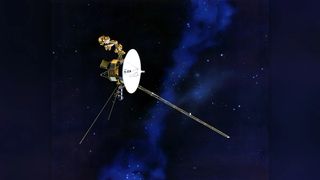
For the past five months, the Voyager 1 spacecraft has been sending a steady stream of unreadable gibberish back to Earth. Now, NASA engineers finally know why.
The 46-year-old spacecraft sends regular radio signals as it drifts further from our solar system . But in November 2023, the signals suddenly became garbled, meaning scientists were unable to read any of its data, and they were left mystified about the fault's origins.
In March, NASA engineers sent a command prompt, or "poke," to the craft to get a readout from its flight data subsystem (FDS) — which packages Voyager 1's science and engineering data before beaming it back to Earth.
After decoding the spacecraft's response, the engineers have found the source of the problem: The FDS's memory has been corrupted.
Related: NASA's Voyager 1 sends readable message to Earth after 4 nail-biting months of gibberish
"The team suspects that a single chip responsible for storing part of the affected portion of the FDS memory isn't working," NASA said in a blog post Wednesday (March 13) . "Engineers can't determine with certainty what caused the issue. Two possibilities are that the chip could have been hit by an energetic particle from space or that it simply may have worn out after 46 years."
— NASA hears 'heartbeat' signal from Voyager 2 probe a week after losing contact
— Historic space photo of the week: Voyager 2 spies a storm on Saturn 42 years ago
— NASA reestablishes full contact with Voyager 2 probe after nail-biting 2-week blackout
Although it may take several months, the engineers say they can find a workaround to run the FDS without the fried chip — restoring the spacecraft's messaging output and enabling it to continue to send readable information from outside our solar system.
Sign up for the Live Science daily newsletter now
Get the world’s most fascinating discoveries delivered straight to your inbox.
Launched in 1977, Voyager 1 zipped past Saturn and Jupiter in 1979 and 1980 before flying out into interstellar space in 2012. It is now recording the conditions outside of the sun's protective magnetic field , or heliosphere, which blankets our solar system.
Voyager 1 is currently more than 15 billion miles (24 billion kilometers) from Earth, and it takes 22.5 hours for any radio signal to travel from the craft to our planet.

Ben Turner is a U.K. based staff writer at Live Science. He covers physics and astronomy, among other topics like tech and climate change. He graduated from University College London with a degree in particle physics before training as a journalist. When he's not writing, Ben enjoys reading literature, playing the guitar and embarrassing himself with chess.
NASA spacecraft snaps mysterious 'surfboard' orbiting the moon. What is it?
The moon is getting its own time zone, White House memo to NASA reveals
Why I watched the solar eclipse with my kids, a goose and 2,000 trees
- TorbjornLarsson Bon voyage, Voyager! Reply
- Jay McHue What if aliens are doing it to try to communicate with us? 🤪 Reply
Jay McHue said: What if aliens are doing it to try to communicate with us? 🤪
admin said: Voyager 1 has been sending a stream of garbled nonsense since November. Now NASA engineers have identified the fault and found a potential workaround. NASA engineers discover why Voyager 1 is sending a stream of gibberish from outside our solar system : Read more
sourloaf said: What does FSB mean?
Rusty Lugnuts said: Where are you seeing "FSB"? The closest thing I can see in the article is "FDS". In modern computers, FSB would most likely refer to the Fr0nt S1ide Bu5, though I have no idea if a system as old as Voyagers, let alone engineered so specifically, would have an FSB. (apparently I can't spell out "Fr0nt S1ide Bu5" or my post gets flagged as spam or inappropriate??)
- SkidWard Just cut the % of ram needed... skip the bad sectors Reply
- kloudykat FDS = fl1ght da1a sub5ystem5 Reply
- 5ft24dave This is pretty old news, like 6 months old. Are you guys just now discovering this? Reply
Commodore Browncoat said: That's about as sane a theory as many of the others that have become ridiculously popular in the past several years, so sure - why not? What reply do you think we should send?
- View All 11 Comments
Most Popular
By Peter Ray Allison April 10, 2024
By Tom Metcalfe April 09, 2024
By Rebecca Sohn April 09, 2024
By Stephanie Pappas April 09, 2024
By Samantha Mathewson April 09, 2024
By Nicoletta Lanese April 09, 2024
By Sascha Pare April 09, 2024
By Emily Cooke April 09, 2024
By Harry Baker April 09, 2024
- 2 Here are the best photos of the April 8 total solar eclipse over North America
- 3 Part of the San Andreas fault may be gearing up for an earthquake
- 4 Pet fox with 'deep relationship with the hunter-gatherer society' buried 1,500 years ago in Argentina
- 5 NASA engineers discover why Voyager 1 is sending a stream of gibberish from outside our solar system
- 2 Pet fox with 'deep relationship with the hunter-gatherer society' buried 1,500 years ago in Argentina
- 3 No, you didn't see a solar flare during the total eclipse — but you may have seen something just as special
- 4 Neolithic women in Europe were tied up and buried alive in ritual sacrifices, study suggests
- 5 Superfast drone fitted with new 'rotating detonation rocket engine' approaches the speed of sound


NASA's Ingenious Efforts to Restore Voyager 1's Interstellar Communications on May,2022
V oyager 1, the venerable space probe and humanity’s most distant emissary, has encountered a communication hurdle that has persisted for months, leading to a valiant effort by NASA engineers to comprehend and rectify the anomaly.
For over 45 years, Voyager 1 has been gliding through the cosmos, and in its lifetime, it has delivered invaluable data on planets like Jupiter and Saturn, as well as a solitary image of Earth from the outskirts of our solar system. Yet, as it cruises over 15 billion miles from Earth, it faces a unique challenge: a breakdown in the way it communicates its observations and status back to ground control.
In May 2022, NASA’s Jet Propulsion Laboratory (JPL) engineers noticed the glitch when Voyager 1 began transmitting nonsensical data. This data, meant to inform mission controllers about the spacecraft’s operations and scientific findings, is crucial for the continuous assessment of the mission’s health and objectives. A JPL spokesperson highlighted the efforts made to resolve the issue: “The team continues information gathering and are preparing some steps that they’re hopeful will get them on a path to either understand the root of the problem and/or solve it.”
The glitch appears to be a discord between the spacecraft’s flight data system (FDS) and its telemetry modulation unit (TMU). Normally, the FDS would collect and package data for transmission to Earth, but the TMU has been sending a repeating pattern of ones and zeroes, rendering the data unintelligible.
Despite this setback, the mission team has made a breakthrough. In March 2023, after sending a ‘poke’ to the spacecraft, a signal was received that stood out from the garbled data stream. A Deep Space Network engineer decoded this and found it contained a readout of the entire FDS’s memory, a potential treasure trove for diagnosing the problem.
The issue is compounded by the enormous distance signals must travel, taking approximately 22 hours each way, leading to a slow, iterative process of trial and error as engineers send commands and await the spacecraft’s response. It’s a process the JPL spokesperson described, noting, “After they do that, they spend a few days digesting the information they got, consulting old documents to see if they can make sense of the little bits of information they can glean from things (since the telemetry data itself is unusable), and then send another command.”
Despite the challenges, the mission team remains hopeful. The wealth of data collected before the communication breakdown continues to shed light on the conditions of interstellar space, and the Voyager probes’ ongoing journey into the cosmos is a testament to human ingenuity and curiosity.
As NASA’s engineers labor to parse the received memory readout and develop potential solutions, Voyager 1’s mission remains a symbol of human achievement. Although the issue remains unresolved, the data sent back before the problem began provides an extensive understanding of interstellar space, and the work to re-establish complete communication is evidence of NASA’s relentless pursuit of knowledge.
Relevant articles:
– NASA Is Still Fighting to Save Its Historic Voyager 1 … , Gizmodo, Mar 7, 2024
– Voyager 1 sends back surprising response after ‘poke’ from NASA , CNN
– NASA finds clue while solving Voyager 1’s communication breakdown case , Space.com
– How was contact restored between NASA and Voyager 2? Here’s all you need to know about the ‘shout’ across interstellar space which retrieved the spacecraft , economictimes.com
![Voyager 1, the venerable space probe and humanity’s most distant emissary, has encountered a communication hurdle that has persisted for months, leading to a valiant effort by NASA engineers to comprehend and rectify the anomaly. For over 45 years, Voyager 1 has been gliding through the cosmos, and in its lifetime, it has delivered invaluable […] Voyager 1, the venerable space probe and humanity’s most distant emissary, has encountered a communication hurdle that has persisted for months, leading to a valiant effort by NASA engineers to comprehend and rectify the anomaly. For over 45 years, Voyager 1 has been gliding through the cosmos, and in its lifetime, it has delivered invaluable […]](https://img-s-msn-com.akamaized.net/tenant/amp/entityid/BB1l0TOd.img?w=768&h=512&m=6)

IMAGES
VIDEO
COMMENTS
Note: Because Earth moves around the sun faster than Voyager 1 is speeding away from the inner solar system, the distance between Earth and the spacecraft actually decreases at certain times of year. Distance from Sun: This is a real-time indicator of Voyagers' straight-line distance from the sun in astronomical units (AU) and either miles (mi ...
Voyager 1 live position and data. This page shows Voyager 1 location and other relevant astronomical data in real time. The celestial coordinates, magnitude, distances and speed are updated in real time and are computed using high quality data sets provided by the JPL Horizons ephemeris service (see acknowledgements for details). The sky map shown in the background represents a rectangular ...
In August 2012, Voyager 1 made the historic entry into interstellar space, the region between stars, filled with material ejected by the death of nearby stars millions of years ago. Voyager 2 entered interstellar space on November 5, 2018 and scientists hope to learn more about this region. Both spacecraft are still sending scientific ...
Voyager 2 Present Position. This simulated view of the solar system allows you to explore the planets, moons, asteroids, comets, and spacecraft exploring our solar system. You can also fast-forward and rewind in real-time. NASA/JPL-Caltech.
Voyager 1 is a space probe launched by NASA on September 5, 1977, as part of the Voyager program to study the outer Solar System and the interstellar space beyond the Sun's heliosphere. It was launched 16 days after its twin Voyager 2.
This is a real-time indicator of Voyager 1's distance from Earth in astronomical units (AU) and either miles (mi) or kilometers (km). Note: Because Earth moves around the sun faster than Voyager 1 is speeding away from the inner solar system, the distance between Earth and the spacecraft actually decreases at certain times of year.
This visualization tracks the trajectory of the Voyager 1 spacecraft through the solar system. Launched on September 5, 1977, it was one of two spacecraft sent to visit the giant planets of the outer solar system. Voyager 1 flew by Jupiter and Saturn before being directed out of the solar system.To fit the 40 year history of the mission into a short visualization, the pacing of time ...
About the mission. Voyager 1 reached interstellar space in August 2012 and is the most distant human-made object in existence. Launched just shortly after its twin spacecraft, Voyager 2, in 1977, Voyager 1 explored the Jovian and Saturnian systems discovering new moons, active volcanoes and a wealth of data about the outer solar system.
Voyager 1 is a space probe launched by NASA on September 5, 1977, to study the outer Solar System and beyond. It is currently the most distant human-made object from Earth, having traveled over 14 billion miles (23 billion kilometers) from the Sun. Voyager 1's mission has included flybys of Jupiter and Saturn, with the goal of studying their moons, rings, and magnetic fields.
December 19, 1977: Voyager 1 overtakes Voyager 2. Voyager 1 is traveling at a speed of 3.6 astronomical units (335 million miles; an AU is equal to the average distance between the Earth and the ...
Voyager 1 is the first spacecraft to travel beyond the solar system and reach interstellar space . The probe launched on Sept. 5, 1977 — about two weeks after its twin Voyager 2 — and as of ...
The Pale Blue Dot is a photograph of Earth taken Feb. 14, 1990, by NASA's Voyager 1 at a distance of 3.7 billion miles (6 billion kilometers) from the Sun. NASA/JPL-Caltech. Voyager 1, meanwhile ...
Now, Voyager 1 is the most distant human-made object from Earth, and has been since it overtook the venerable Pioneer 10 in 1998. As of March 2018, Voyager 1 is over 13 billion miles away—or 141 times farther from the sun than Earth is. Map showing the trajectories of Voyagers 1 and 2 and their predecessors, Pioneers 10 and 11.
Mission Overview. The twin Voyager 1 and 2 spacecraft are exploring where nothing from Earth has flown before. Continuing on their more-than-40-year journey since their 1977 launches, they each are much farther away from Earth and the sun than Pluto. In August 2012, Voyager 1 made the historic entry into interstellar space, the region between ...
Voyager 2 is now more than 96 AU from the sun, traveling at a speed of 15.5 kilometers per second (9.6 miles per second). Both spacecraft are moving considerably faster than Pioneers 10 and 11, two earlier spacecraft that became the first robotic visitors to fly past Jupiter and Saturn in the mid-70s. This processed color image of Jupiter was ...
NASA's two Voyager spacecraft are hurtling through unexplored territory on their road trip beyond our solar system. Along the way, they are measuring the interstellar medium, the mysterious environment between stars. NASA's Hubble Space Telescope is providing the road map - by measuring the material along the probes' future trajectories.
Jet Propulsion Laboratory, Pasadena, Calif. 818-354-0724. [email protected]. Dwayne Brown. 202-358-1726. [email protected]. 2012-381. NASA's Voyager 1 spacecraft has entered a new region at the far reaches of our solar system that scientists feel is the final area the spacecraft has to cross before reaching interstellar space.
We now have five spacecraft that have either reached the edges of our solar system or are fast approaching it: Pioneer 10, Pioneer 11, Voyager 1, Voyager 2 and New Horizons. Most of these probes ...
NASA's Solar System Interactive (also known as the Orrery) is a live look at the solar system, its planets, moons, comets, and asteroids, as well as the real-time locations of dozens of NASA missions.
Voyager 1 currently sits around 15 billion miles (24 billion kilometers) from Earth, which means it takes 22.5 hours to receive a radio signal from it — and another 22.5 hours for the spacecraft ...
Launched in 1977, Voyager 1 zipped past Saturn and Jupiter in 1979 and 1980 before flying out into interstellar space in 2012. It is now recording the conditions outside of the sun's protective ...
Launched in 1977, NASA's Voyager 1 became the first spacecraft to travel beyond our solar system into interstellar space in 2012.
Voyager 1, the venerable space probe and humanity's most distant emissary, has encountered a communication hurdle that has persisted for months, leading to a valiant effort by NASA engineers to ...
Voyager 1 flew within 64,200 kilometers (40,000 miles) of the cloud tops, while Voyager 2 came within 41,000 kilometers (26,000 miles). Saturn is the second largest planet in the solar system. It takes 29.5 Earth years to complete one orbit of the Sun, and its day was clocked at 10 hours, 39 minutes. Saturn is known to have at least 17 moons ...
The glitch paused Voyager 1's science work and kicked off a long-distance diagnosis process. The team traced the issue to the flight data subsystem, a computer that talks to the spacecraft's ...